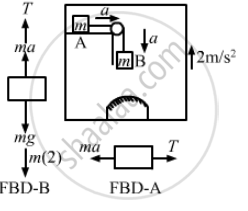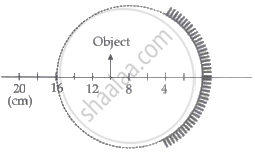Advertisements
Advertisements
प्रश्न
Consider the situation shown in figure. The elevator is going up with an acceleration of 2.00 m s−2 and the focal length of the mirror is 12.0 cm. All the surfaces are smooth and the pulley is light. The mass-pulley system is released from rest (with respect to the elevator) at t = 0 when the distance of B from the mirror is 42.0 cm. Find the distance between the image of the block B and the mirror at t = 0.200 s. Take g = 10 m s−2.

उत्तर
Given,
Acceleration of the elevator, a = 2.00 m/s2
Focal length of the mirror M, f = 12.00 cm
Acceleration due to gravity, g = 10 m/s2
Mass of blocks A and B = m
As per the question, the mass–pulley system is released at time t = 0.
Let the acceleration of the masses A and B with respect to the elevator be a.
Using the free body diagram,
T − mg + ma − 2m = 0 ...(i)
Also,
T − ma = 0 ...(ii)
From (i) and (ii), we get:
2ma = m(g + 2)
`⇒ a = (10 + 2)/2`
`= 12/2 = 6 ms^-2`
Now, the distance travelled by block B of mass m in time t = 0.2 s is given by
`s = ut + 1/2at^2`
As `(u = 0)`
`s = 1/2 at^2`
On putting the respective values, we get:
`s = 1/2 xx 6 xx (0.2)^2`
`= 0.12 m = 12 cm`
As given in the question, the distance of block B from the mirror is 42 cm.
Object distance u from the mirror = − (42 − 12) = − 30 cm Using the mirror equation,
`1/v + 1/u = 1/f`
On putting the respective values, we get:
`1/v + 1/-30 = 1/12`
⇒ `1/v= 1/-30 = 1/ 12 + 1/30`
⇒ `v = 8.57 cm `
Hence, the distance between block B and mirror M is 8.57 cm.
APPEARS IN
संबंधित प्रश्न
A 4.5 cm needle is placed 12 cm away from a convex mirror of focal length 15 cm. Give the location of the image and the magnification. Describe what happens as the needle is moved farther from the mirror.
A double convex lens is made of a glass of refractive index 1.55, with both faces of the same radius of curvature. Find the radius of curvature required, if the focal length is 20 cm.
In motor vehicles, a convex mirror is attached near the driver's seat to give him the view of the traffic behind. What is the special function of this convex mirror which a plane mirror can not do?
Light is incident from glass (μ = 1.5) to air. Sketch the variation of the angle of deviation δ with the angle of incident i for 0 < i < 90°.
A spherical surface of radius 30 cm separates two transparent media A and B with refractive indices 1.33 and 1.48 respectively. The medium A is on the convex side of the surface. Where should a point object be placed in medium A so that the paraxial rays become parallel after refraction at the surface?
A narrow pencil of parallel light is incident normally on a solid transparent sphere of radius r. What should be the refractive index is the pencil is to be focussed (a) at the surface of the sphere, (b) at the centre of the sphere.
A converging lens of focal length 12 cm and a diverging mirror of focal length 7.5 cm are placed 5.0 cm apart with their principal axes coinciding. Where should an object be placed so that its image falls on itself?
A converging lens of focal length 40 cm is kept in contact with a diverging lens of focal length 30 cm. Find the focal length of the combination .
Two thin lenses having optical powers of -10D and+ 6D are placed in contact with each other. The focal length of the combination is:
Answer the following question.
Under what conditions is the phenomenon of total internal reflection of light observed? Obtain the relation between the critical angle of incidence and the refractive index of the medium.
According to Cartesian sign convention, all distances are measured from the _______.
Focal length of a mirror is given by ______.
A thin converging lens of focal length 12 cm is kept in contact with a thin diverging lens of focal length 18 cm. Calculate the effective/equivalent focal length of the combination.
The focal length of a convex lens made of glass of refractive index (1.5) is 20 cm.
What will be its new focal length when placed in a medium of refractive index 1.25?
Is focal length positive or negative? What does it signify?
The radius of curvature of the curved surface of a plano-convex lens is 20 cm. If the refractive index of the material of the lens be 1.5, it will ______.
A short object of length L is placed along the principal axis of a concave mirror away from focus. The object distance is u. If the mirror has a focal length f, what will be the length of the image? You may take L << |v – f|.
A spherical mirror is obtained as shown in the figure from a hollow glass sphere. if an object is positioned in front of the mirror, what will be the nature and magnification of the image of the object? (Figure drawn as schematic and not to scale)

An object is 20 cm away from a concave mirror and it is within the focal length of the mirror. If the mirror is changed to a plane mirror, the image moves 15 cm closer to the mirror.
Focal length of the concave mirror is ______.
Why does a car driver use a convex mirror as a rear-view mirror?
